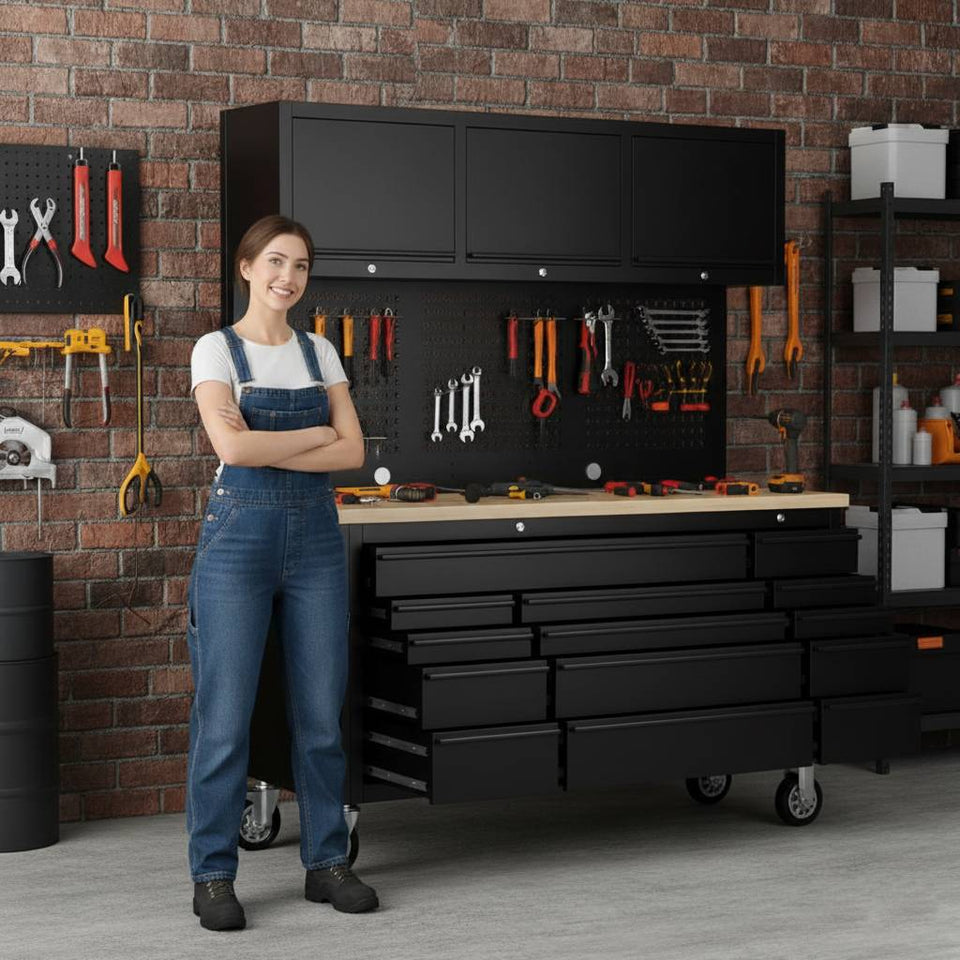When shopping for a high-end steel tool cabinet—especially one with a full workbench, overheads, and drawers—it's easy to get caught up in surface specs. Two models might look nearly identical in size and layout, but one weighs 375 lbs and the other 459 lbs. So what gives?
That 84 lb difference isn’t just dead weight—it’s a clue. Here's how to decode it and make sure you're investing in real strength, not just marketing gloss.
⚖️ Weight Isn’t Everything—But It Tells a Story
Steel density is constant. So if two cabinets are the same size and design, a heavier unit likely uses:
- Thicker steel panels
- More internal bracing
- Heavier-duty drawer slides or casters
- Denser worktop or overhead cabinet materials
Before assuming the heavier unit is better, dig deeper into what contributes to that weight—and whether it translates to usable strength.
🔍 Step-by-Step Comparison Guide
1. Check Steel Thickness (Gauge or mm)
Most tool cabinets use cold-rolled steel measured in either gauge (U.S.) or millimeters (metric). Lower gauge = thicker steel.
| Gauge | Approx. Thickness (mm) |
|---|---|
| 18 | ~1.2 mm |
| 20 | ~0.9 mm |
| 22 | ~0.75 mm |
If one cabinet uses 0.7 mm panels and the other uses 0.8 mm, that alone can partly explain a 50+ lb difference. Thicker steel resists flexing, denting, and drawer warping—especially under load.
Tip: Look for reinforcement in drawer fronts, side panels, and caster mounts. Thin steel with no bracing will twist under stress.
2. Inspect Drawer Slide Ratings
Drawer load ratings are a direct measure of strength. A 100 lb slide is solid for most hand tools and power tools. If the heavier cabinet uses 120–150 lb slides, that adds weight and durability.
Bonus: Ball-bearing slides with full extension add weight but improve access and longevity.
3. Evaluate Frame Rigidity
Rigidity comes from how the cabinet is built—not just the steel thickness.
- Welded corners vs. riveted or bolted frames
- Cross-bracing behind drawers or in side panels
- Caster mounting plates that distribute load
A heavier cabinet may include internal gussets or full-length reinforcements that prevent racking (twisting under load). That’s a big win for long-term durability.
4. Assess the Worktop and Overhead Cabinet
If both units have a 72" wood workbench and overhead cabinet, check:
- Workbench thickness and material (solid wood vs. MDF or veneer)
- Overhead cabinet construction (steel vs. composite)
- Mounting method (bolted vs. welded)
These components can add 20–30 lbs alone—and affect how the unit handles vibration, tool impact, and long-term wear.
5. Caster Quality and Load Rating
Six-inch casters are ideal for garage floors, but not all are equal.
- Steel core vs. plastic
- Ball-bearing swivel vs. fixed axle
- Load rating per caster
Higher-grade casters add weight but improve mobility and stability—especially when rolling a fully loaded 72" chest.
🧪 Real-World Test: The Knock Test
If you’re inspecting in person, try this:
- Tap the side panels: A hollow ring = thinner steel
- Push on drawer fronts: Flex = weak gauge or poor bracing
- Rock the unit side to side: Excess sway = poor frame rigidity
🏁 Final Verdict: What That Extra 84 lbs Might Mean
If the heavier cabinet uses thicker steel, better slides, reinforced framing, and higher-grade casters, it’s likely the stronger, more durable choice—even if both look the same on paper.
But if the weight comes from denser wood or unnecessary bulk, you might be paying for mass—not muscle.
💡 Pro Tip for Buyers
Ask for:
- Steel thickness in mm or gauge
- Drawer load ratings
- Caster specs
- Frame construction details
- Warranty terms (especially for drawer slides and casters)
And if you're outfitting a garage with a 2-car layout, make sure the unit fits your wall space without compromising parking clearance.





